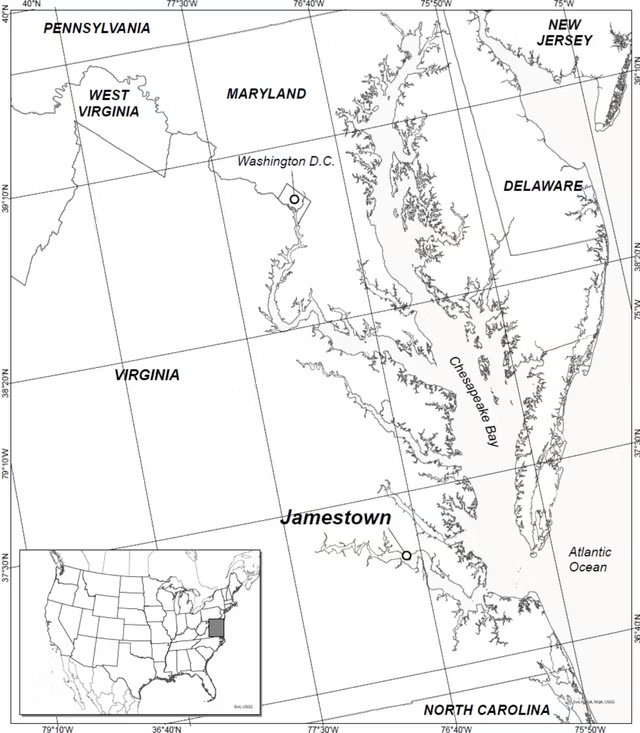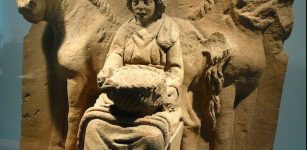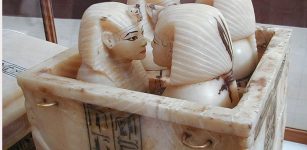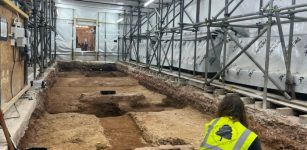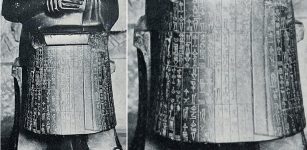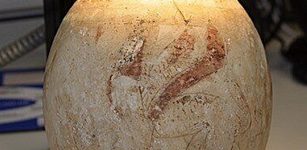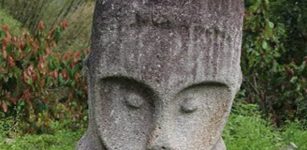America’s Oldest Tombstone: Jamestown’s Black “Marble” Knight’s Tombstone Was Imported From Belgium
Jan Bartek - AncientPages.com - Jamestown, Virginia, established in 1607, holds the distinction of being the first permanent English settlement in America. It has been extensively studied through archaeological and historical research.
The 1627 knight’s tombstone from the chancel of Jamestown Memorial Church, Jamestown, VA, USA. Stone is 172 cm long by 80 cm wide. Photo credit - Courtesy of Jamestown Rediscovery (Preservation Virginia)
Recently, scientists embarked on a quest to trace the origins of Jamestown’s black “marble” knight’s tombstone, leading to an unexpected discovery. This tombstone, dating back to 1627, is recognized as the oldest of its kind in the Chesapeake Bay region.
The knight’s tombstone measures 171.9 cm long by 80.4 cm wide by 12.2 cm thick (i.e., 68 in × 32 in × 5 in). Compared to other colonial-era black “marble” tombstones from the Chesapeake Bay colonies, it is on the shorter and narrower ends of the size range but of average thickness.
Archaeologists had long known this tombstone belonged to a knight and was erected in 1627 at Jamestown. However, its exact European origin remained a mystery until now. In a recent study published in the International Journal of Historical Archaeology by Professor Marcus M. Key and Rebecca K. Rossi from Dickinson College in Pennsylvania, new insights have emerged regarding this enigmatic artifact.
The researchers discovered that the tombstone featured a carved depression likely intended for brass inlays depicting a shield, an unfurled scroll, and an armored figure. Historical records indicate that two knights died in Jamestown during the 17th century: Sir Thomas West (in 1618) and Sir George Yeardley (in 1627). Interestingly, Sir Yeardley’s step-grandson commissioned a similar tombstone for himself with identical inscriptions during the 1680s.
Jamestown archaeological site in Virginia. Credit: Marcus Key et al International Journal of Historical Archaeology
This evidence led researchers to hypothesize that the original 1627 tombstone belonged to Sir George Yeardley. Born in Southwark, England, in 1588, Yeardley arrived at Jamestown after surviving a shipwreck near Bermuda in 1610. He was knighted by King James I upon returning to England in 1617 and returned to Jamestown as Governor General before his death there in November 1627.
To pinpoint its origins, further accurate identification of its source material's microfossils within archived stone fragments revealed six species of foraminiferans co-occurring exclusively during Belgium's Viséan Age, Middle Mississippian Epoch, Carboniferous Period Ireland—distinctly absent North America—conclusively tracing slab European roots.
In their study, Professor Marcus M. Key and Rebecca K. Rossi explain that historical evidence indicates that Belgium, from where the black “marble” knight’s tombstone was transshipped to London and subsequently to Jamestown, has long been a significant source of Lower Carboniferous black “marbles” since Roman times. These Belgian black “marble” ledger stones were exported extensively to various regions, including Sweden, Poland, Madeira, France, Scotland, and England.
From the Middle Ages through the mid-seventeenth century—and experiencing a resurgence in the eighteenth and nineteenth centuries—black “marble” became highly fashionable among affluent English individuals for commemorating their deceased. The jet-black Belgian “marbles” were particularly sought after and commanded high prices. Successful Virginia colonists who had resided in London would have been well-acquainted with contemporary English fashions and endeavored to replicate these trends within the colonies.
For colonists such as Yeardley, a black marble ledger stone served as a testament to his accomplishments and virtues and prominently signified his family's elite status in colonial society. The expense of importing such stones to Jamestown—despite using them as ballast—would have significantly increased due to costs associated with the stone itself, its carving for brass inlays, and the fabrication and fitting of these inlays.
The individual interred beneath this knight’s tombstone was undoubtedly a distinguished member of the Jamestown settlement. Historical and archaeological evidence further elucidates that manufactured goods were imported into colonial Maryland and Virginia from Europe—primarily England—from the seventeenth century onwards. A well-documented example includes building materials such as stones, hardware, glassware, and paint imported from England for use in Virginia’s colonial capital, Williamsburg.
Expensive manufactured items like ledger stones were more frequently imported from England compared to less costly locally available materials like bricks. In Virginia, up until 1780, tombstones were predominantly imported from England; however, by 1740, Maryland began sourcing more tombstones from Philadelphia.
This study is anticipated to refine our understanding of seventeenth-century North Atlantic trade routes between Continental Europe (especially Belgium), England, and colonial Virginia.
Additionally, found within the graveyard outside Jamestown Memorial Church are two other black limestone ledger tombstones belonging to William Sherwood (died 1697) and Mrs. Sarah Blair (died 1713).
The study was published in the International Journal of Historical Archaeology
Written by Jan Bartek - AncientPages.com Staff Writer


